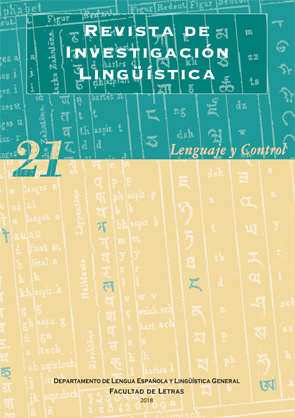evolution of linguistics classifications methodologies
Estado de la cuestión y los nuevos desarrollos en la metodología de clasificación lingüística
Abstract
In this work we try to make a panoramic view of the different methodologies applied to date ancient and proto-languages. The inicial effort of M. Swadesh, highly criticised, had evolved to new methods linked with database and phylogenetics. Our goal is to show how this new methodology can help the scholar and how to apply this in a linguistics or a history of the language clashroom. Projects like Ielex, ASJP or GDL show the importance of l exicostatistics and constitute a field with a great potential in teaching and research.
Downloads
-
Abstract931
-
PDF (Español (España))863
References
BOUCHARD-CÔTÉ, A., et. al. (2009), «Improved Reconstruction of Protolanguage Word Forms». Proceedings of the North American Chapter of the Association for Computational Linguistics (NAACL09). 7, 65-73.
BOUCKAERT, R., LEMEY, P., DUNN, M., GREENHILL, S. J., ALEKSEYENKO, A. V., DRUMMOND, A. J., GRAY, R. D., SUCHARD, M. A., & ATKINSON, Q. D. (2012) «Mapping the origins and expansion of the Indo-European language family». Science, 337, 957–960.
COSERIU, E. (1965), «Critique de la glottochronologie appliquée aux langues romanes.» Linguistique et Philologie Romanes. Xe Congrès International de Linguistique et Philologie Romanes. París: Klincksieck.
DYEN, I., KRUSKAL, J. B., BLACK, P. (1992), An Indoeuropean Classification: A Lexicostatistical Experiment, The American Philosophical Society, Philadelphia.
EHRET, CH. (2000), «Testing the Expectations of Glottochronology against the Correlations of Language and Archeology in Africa.» en Colin Renfrew, April McMahon and Larry Trask, (eds.) Time Depth in Historical Linguistics, Cambridge: MacDonald Institute for Archaeological Research, 373-399.
JÄGER, G. (2014), «Lexikostatistik 2.0», en A. Plewnia & A. Witt, eds., Sprachverfall? Dynamik - Wandel - Variation. Jahrbuch 2013 des Instituts für Deutsche Sprache, Berlin, de Gruyter, 197-216.
MARCHUK, Y. N. (2003), «The Burdens and Blessings of Blazing the Trail». Journal of Quantitative Linguistics. Bd. 10, 2 , 81–85
JÄGER, G. (2016), Investigating the potential of ancestral state reconstruction algorithms in historical linguistics, C. Bentz, G. Jäger and I. Yanovich, eds.
PEÑA, C. (2011), «Métodos de inferencia filogenética», Rev. Per. biol. 18(2), 265-267.
SAPIR, E. (1921), Language. An introduction to the study of speech, New York, Brace.
STAROSTIN, S. (2007), Opredelenije ustojčivosti bazisnoj leksiki [Defining the Stability of Basic Lexicon] // S. Starostin. Trudy po jazykoznaniju [Works in Linguistics]. Moscow, Jazyki slav’anskix kul’tur, (2007) 825–839
STAROSTIN, G. (1989), "Sravnitel'no-istoričeskoe jazykoznanie i leksikostatistika", en "Lingvističeskaja rekonstrukcija i drevnejšaja istorija Vostoka", Moscú (trad. al inglés por I. Peiros y N. Evans Comparative-historical linguistics and lexicostatistics. Historical Linguistics and Lexicostatistics), 3-50
STAROSTIN, G. (2010), Preliminary lexicostatistics as a basis for language classification: A new approach, Journal of Language Relationship, No. 3: 79–116
STAROSTIN, G. (Ed.) (2011-2016), The Global Lexicostatistical Database. Moscow: Russian State University for the Humanities, & Santa Fe: Santa Fe Institute. Disponible online en http://lexstat.tk/databases/, acceso [28-5-2016].
SWADESH, M. (1955), «Towards Greater Accuracy in Lexicostatistic Dating.» International Journal of American Linguistics. 21: 121- 137.
SWADESH, M. (1958), «Sobre la clasificación del otomí-pame», Аctas del 33 Congreso Internacional de Americanistas 2: 551-559.
SWADESH, M. (1971), The Origin and Diversification of Language. Aldine, Chicago.
The works published in this magazine are subject to the following terms:
1. The Publications Service of the University of Murcia (the publisher) preserves the economic rights (copyright) of the published works, and favors and allows the reuse of same under the license of use indicated in point 2.
2. The papers are published in the electronic edition of the magazine under a Creative Commons Attribution-NonCommercial-NoDerivative 3.0 Spain license (legal text). Papers may be copied, used, disseminated, transmitted and publicly exhibited if the following requirements are met: i) The authorship and the original source of its publication (magazine, editorial and URL of the work) must be cited; ii) The works cannot be used for commercial purposes; iii) The existence and specifications of this user license must be explicitly mentioned.
3. Self-archiving conditions. Authors can electronically disseminate pre-print versions (version before being evaluated) and / or post-print versions (version evaluated and accepted for publication). This makes possible its circulation and diffusion earlier and with it a possible increase in its citation and reach among the academic community. RoMEO color: green.









